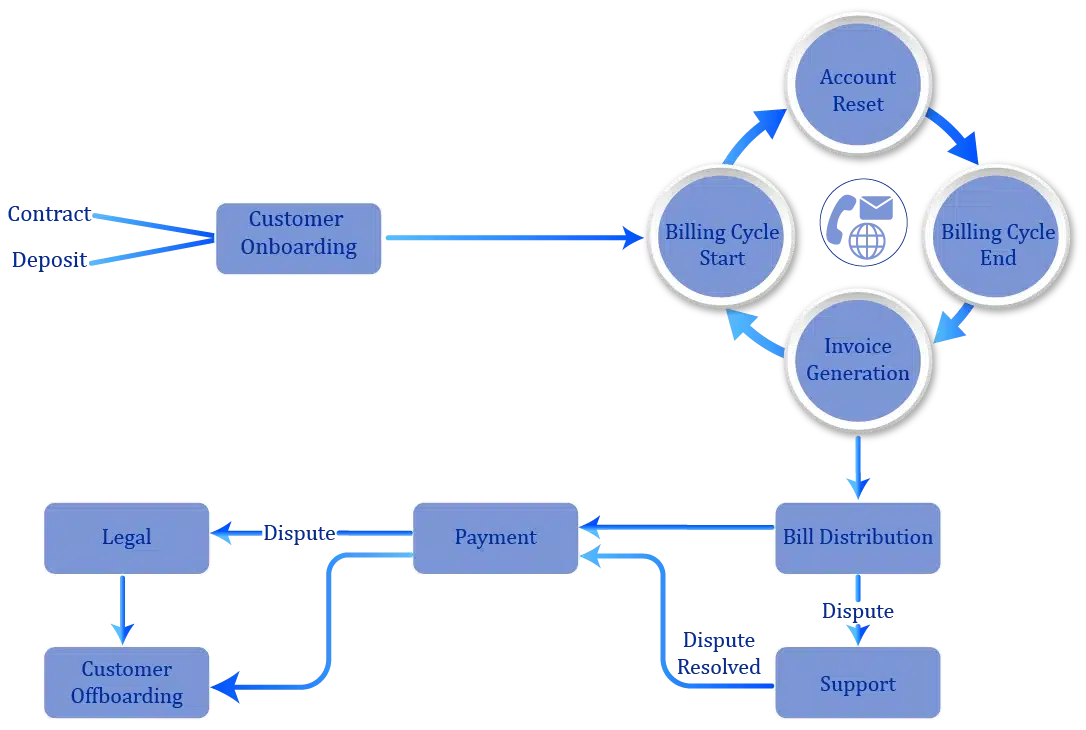Postpaid Billing
A prepaid billing plan requires an upfront payment, whereas a postpaid billing plan allows customers to pay for services at the end of the month rather than at the beginning of the month. This means customers can continue to use services like voice, data, and text messages during the month. Also, it allows customers to select from any available plan and bundle to match their specific needs and preferences.
What is Postpaid Billing?
Postpaid billing is a payment mechanism for companies. Company allows its customers to use their service first, then charges them according to their usage at the end of a billing cycle. Mostly, postpaid plans come with monthly plans. This plan has a predefined number of calls, text messages and data, as well as the flexibility of using more than what has been allocated under specific conditions.
With a postpaid billing service, customers do not need to monitor their account balance immediately or top up their account balance at any given time. As a result, seamless and uninterrupted service will be provided to the customer. Additionally, it helps companies to maintain a consistent revenue stream.

The above diagram details the high level of postpaid billing from a service provider’s perspective. Here’s a step-by-step explanation:
| 1. | Customer Onboarding | In the initial stage, customer signs the contract for the service and pays the initial deposit if there are. Most of the time after signing up as per the law of the land, verify customer details, set up an account in the system and allocate the selected postpaid billing plan. |
| 2. | Billing Cycle Start | After customer onboarding, the billing cycle begins. As per the billing period (often monthly) customer’s usage of the service is tracked. |
| 3. | Billing Cycle End | At the end of the billing period, all usage of the service within that billing cycle has been recorded and will be considered in the invoice. |
| 4. | Invoice Generation | The rating engine/billing mediation does the calculation based on customer usage and plan subscribed to. Services used and corresponding charges are detailed in the invoice. |
| 5. | Account Reset | Once the invoice is generated, the billing cycle starts again and the account resets all usage tracking. |
| 6. | Bill Distribution | Here invoices will be delivered to the customer, through physical mail, email or an online account portal. |
| 7. | Payment | It is expected that the customer will make payment for the invoice on or before the due date. Payment methods can vary and might include direct debit, credit card, online payments, or in-person payments. |
| 8. | Support | If a customer has any questions or issues with billing, support mechanisms are in place to resolve these queries. |
| 9. |
Legal |
In most cases, this refers to any legal actions or procedures that may arise if there are disputes, unpaid bills, or problems regarding contract termination. |
| 10. |
Customer Offboarding |
Either the customer decides to end their relationship with the company or if the company terminates the service, the customer goes through an offboarding process in which the service is discontinued, account deactivation. |
Pros and Cons of Postpaid Billing
Pros:
-
- Credit Trust: Postpaid plans do not require upfront payments, which is one of the reasons why they are attractive to many customers.
- Bundled Offers: Postpaid billing offers comprehensive packages that come with voice, data, and SMS. Also, additional benefits like international roaming and access to other special services.
- Family Plans: Most companies offer a shared family plan, which makes it possible to set up a single account for multiple customers, thus making billing easier.
- Cost-effective: Postpaid billing plans are preferred by many customers because they are less expensive than prepaid plans and offer more services at the same price.
Cons:
-
- Unexpected Charges: Customers may complain that the charges applied for overages or services not covered in their plan, resulting in bill shocks when they receive their bills.
- Complex Contracts: Typically, postpaid contracts contain complex and difficult-to-understand terms and conditions, which may lead to customer confusion and dissatisfaction.
- Billing Errors: Billing errors may occur due to system failure or human error, so it is imperative to monitor the situation closely and to request customer assistance if any disputes arise.
👉 How Does Postpaid Billing Work in EarnBill?
👉 Future predictions for Postpaid Billing.
